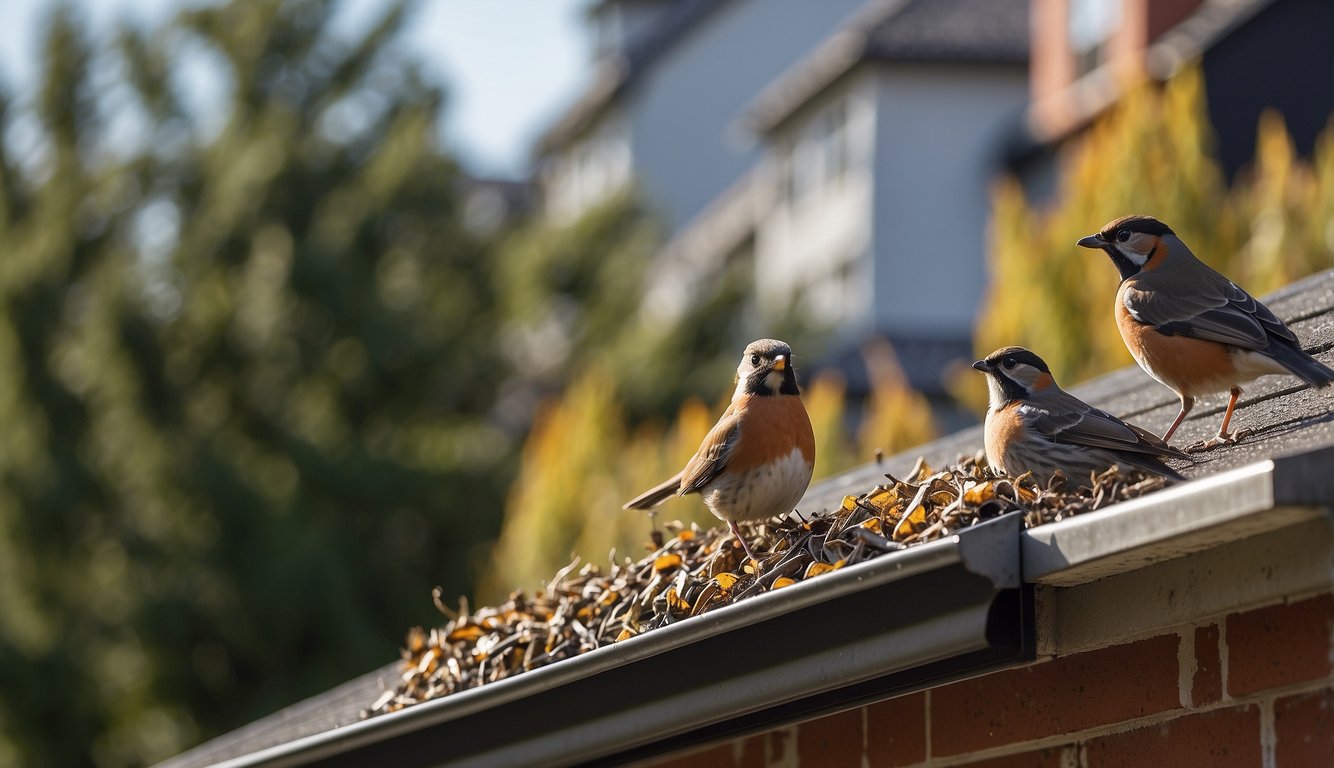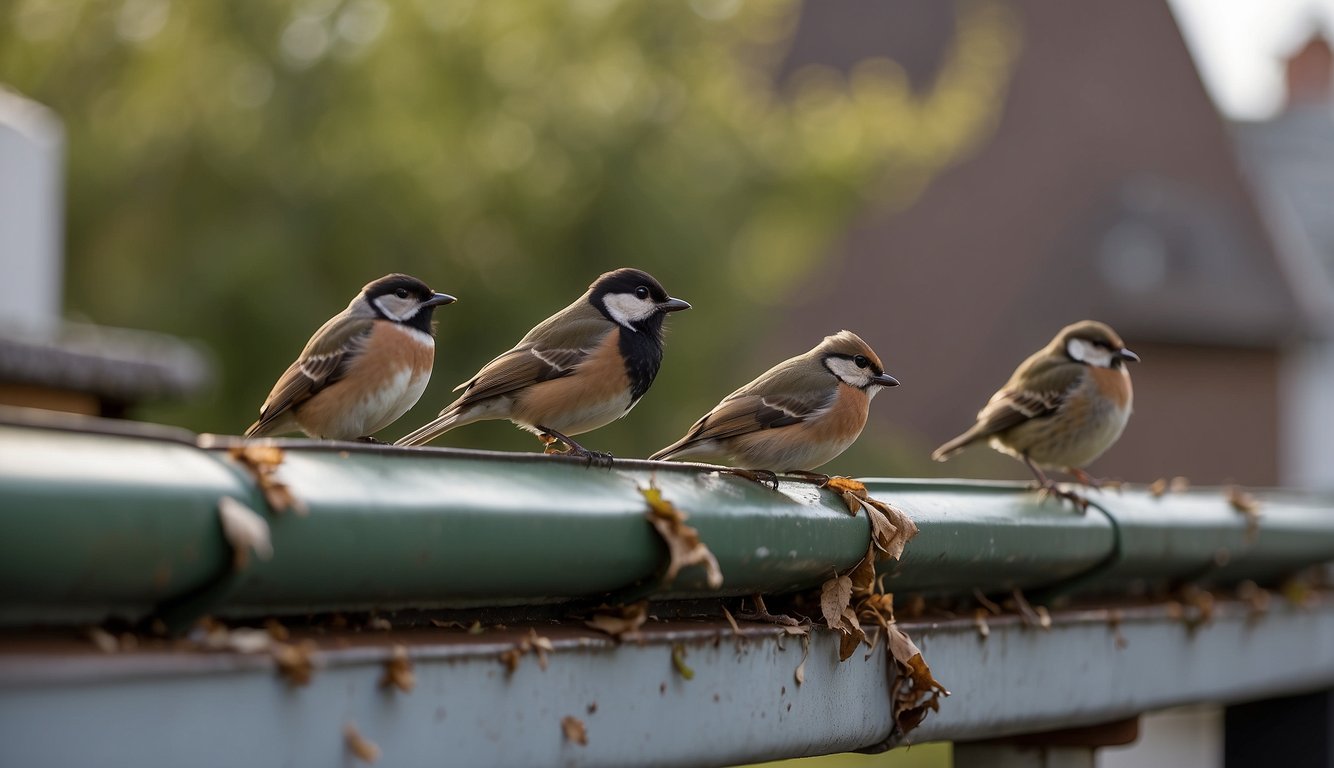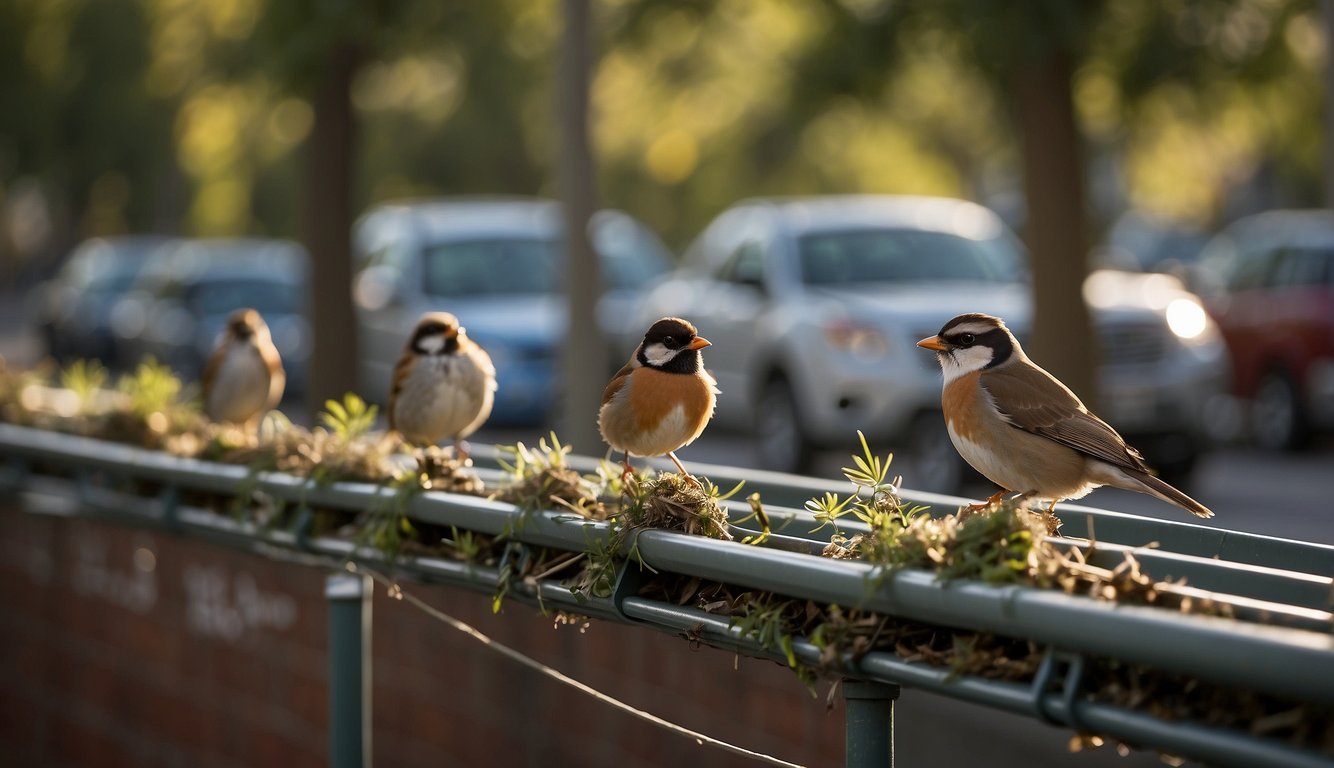How to Get Rid of Birds in Gutters: Effective Nesting Prevention Strategies
Birds nesting in gutters can create significant blockages and potentially damage your home’s drainage system. It’s important to address this issue promptly to maintain the functionality of your gutters and to protect your property from water damage. Various methods can be employed to deter birds from making nests in the guttering, ensuring that rainwater can flow freely away from your roof and foundation.

We can start by making the gutters less appealing to birds by keeping them clean and free of debris. This reduces the sheltered spaces that birds look for when nesting. Another effective strategy is the installation of gutter guards or spikes that prevent birds from landing and constructing nests. Additionally, using visual deterrents like reflective objects or decoys can discourage birds from approaching the gutters.
Regular maintenance and a few simple adaptations can make a significant difference in preventing birds from nesting in your gutters. By employing these measures, we safeguard our homes against damage caused by blocked gutters and also create an environment that’s less inviting for birds to settle in.
Why Do Birds Like To Nest in Gutters?

When dealing with birds nesting in gutters, it is crucial to understand their behaviors and nesting habits. This knowledge will enable us to implement more effective deterrents.
Bird Species Commonly Found in Gutters
Sparrows and starlings are among the most common species that find gutters an attractive site for nesting. These adaptable birds look for secure and sheltered spots to build their nests, and unfortunately, our gutters often fit the bill.
The Nesting Season and Breeding Patterns
The nesting season typically peaks in spring and can extend into early summer. During this time, these birds are actively seeking out ideal spots to lay their eggs and raise their young. Understanding the breeding patterns of sparrows and starlings can help us anticipate and prevent nesting in our gutters.
Reasons Birds Choose Gutters for Nesting
Birds, specifically sparrows and starlings, see gutters as prime real estate for several reasons:
- Shelter: Gutters provide cover from predators and the elements.
- Structure: The enclosed space of a gutter mimics natural cavities these birds prefer.
- Proximity to Food: Gutters are often near gardens or areas with abundant insect activity, providing an excellent food source for raising chicks.
By grasping the preferences of these birds, we can make gutters less inviting and discourage them from taking up residence.
Preventive Measures to Deter Birds

To keep gutters bird-free, it’s crucial to both deter and prevent birds from seeing your gutters as a potential nesting spot. We’ll cover practical measures to ensure your gutter remains functioning and unobstructed by nests.
Benefits of Installing Gutter Guards
- Prevention: Gutter guards act as a physical barrier to prevent birds from accessing and nesting in your gutters.
- Cost-Effectiveness: By installing gutter guards, you minimize the need for continual bird removal, which can be cost-intensive over time.
Types of Gutter Guards:
| Type | Description | Effectiveness |
|---|---|---|
| Mesh | Fine metal screens that fit over the top of gutters. | High |
| Reverse Curve | Guides rainwater in while keeping debris and birds out. | Moderate |
| Bottle Brush | Bristles facing upward to catch debris while allowing water to flow. | Moderate |
Using Visual and Auditory Bird Deterrents
Visual deterrents: Installing decoys like plastic owls or reflective tape can scare birds from approaching your gutters, mirroring the presence of predators.
Auditory deterrents: Noise devices that emit sounds, like ultrasonic noises, can discomfort and drive birds away without causing harm.
Strategies for Visual and Auditory Deterrents:
- Strategically Placed Decoys: Change their positions regularly to prevent birds from growing accustomed to them.
- Reflective Objects: Hang reflective tape or CDs near gutters to utilize sunlight in startling birds.
- Sound Emitters: Install them in areas where birds frequent but ensure the sound levels are in accordance with local noise regulations.
The Importance of Regular Gutter Cleaning
- Health of Gutters: Regular maintenance helps to identify and remove any beginning nests before they become a larger issue.
- Efficiency: Clean gutters allow for optimal water flow and prevent damage or overflow that can be caused by blockages.
Gutter Cleaning Equipment:
| Equipment | Use |
|---|---|
| Gloves | Hand protection and cleaning out debris. |
| Ladder | Safely access gutter height. |
| Hose | Rinse away residue and check water flow. |
Regular gutter cleaning: It should be done twice a year or more in areas with many trees. Consider hiring a professional if you’re not comfortable working on a ladder.
By implementing these preventive strategies, you ensure your gutters stay clear and your home remains protected from the common problems caused by nesting birds.
Effective Removal of Existing Bird Nests
When tackling the removal of nests from gutters, it’s important to stay safe and ensure the correct steps are followed for an effective clean-out.
Safety Considerations and Protective Gear
Before we begin, we must take the necessary safety precautions and wear the right protective gear. Here is what we’ll need:
- Gloves: Thick gloves to prevent any injury from debris and protect from bird-related diseases.
- Safety Goggles: To safeguard our eyes against dirt and nest particles that may become airborne during removal.
- Ladder: A stable ladder is essential for safely reaching the gutters.
Step-by-Step Process for Removing Nests
Now that we’re geared up, let’s follow this straightforward process to remove bird nests from our gutters:
Inspect the Nest:
- Check if the nest is currently in use by observing any bird activity.
- Ensure that removing the nest complies with local wildlife conservation laws.
Prepare for Removal:
- If the nest is unused, position our ladder securely and gather a bag for nest debris.
Careful Removal:
- Gently remove the nest and any debris such as leaves, ensuring the gutters are not clogged.
- Be mindful of handling feathers or other materials that may carry pathogens.
Disposal:
- Place the nest and debris into a bag.
- Dispose of it properly, in compliance with local regulations.
By carefully following these steps, we’ll protect our home from clogged gutters due to bird nests and maintain a clear water flow.
Mitigating Factors That Attract Birds to Gutters

Before taking any measures, it’s important to identify the factors that attract birds to your gutters. These typically involve accessibility to food and water sources as well as comfortable nesting sites.
Addressing Nearby Water and Food Sources
Birds are drawn to gutters for water and nearby food sources. To mitigate this:
- Eliminate Standing Water: Ensure your gutters are well-maintained to prevent rainwater from pooling. Regularly cleaning your gutters will discourage birds seeking water.
- Remove Bird Feeders: If you have bird feeders close to your gutters, consider moving them further away. This reduces the food supply that may be attracting birds to settle in your gutters.
Landscaping and Tree Trimming to Prevent Access
Strategic landscaping and tree maintenance can deter birds from accessing your gutters. Here’s how we can do that:
- Trim Trees: Prune branches that hang over your home, as they provide direct access to your gutters. Keep trees well-trimmed to minimize nesting opportunities.
- Rethink Plant Choices: Opt for plants that aren’t as attractive to birds near your home, thus cutting down the available food sources nearby your gutters.
Legal and Ethical Considerations in Bird Control

When dealing with bird control, particularly in gutters, we must navigate the intersection of legal mandates and ethical responsibilities. It’s crucial to understand relevant wildlife protection laws and employ humane methods to ensure our actions are legally sound and ethically grounded.
Understanding Wildlife Protection Laws
Legislation:
In managing birds, we’re bound by the Migratory Bird Treaty Act (MBTA) of 1918, which provides protection to bird species, their nests, and eggs from being harmed or disturbed. This federal law is enforced by the U.S. Fish and Wildlife Service and underscores the importance of respecting wildlife when considering bird control measures.
- Protected species: Notably, birds of prey are covered under this Act, and violations can lead to significant penalties.
- State regulations: Furthermore, local wildlife conservation laws may have additional restrictions, so it’s advisable to consult your state’s Fish and Wildlife Conservation Commission or the equivalent agency.
Humane Methods for Bird Prevention and Removal
Non-lethal Deterrents:
Ethical bird control favors humane, non-lethal deterrents to prevent birds from nesting in areas like gutters. Here, the goal is to dissuade rather than harm, protecting both the animals and homeowners from any repercussions.
- Environmental responsibility: Choose eco-friendly options that minimize harm to other wildlife and the environment. Examples include physical barriers like gutter guards or spikes specifically designed to deter birds without causing injury.
- Consultation: Seeking guidance from relevant authorities or wildlife experts can aid in implementing the most appropriate and humane strategies for your home.
Let Us Know How We’re Doing!
Did this expertly prepared resource answer your question?
Do you have another question about home maintenance, home improvement projects, home appliance repair, or something else?
Get more information, send in questions and keep the discussion going by contacting the I’ll Just Fix It Myself company customer service team at at 1-800-928-1490 or Email us at [email protected]
